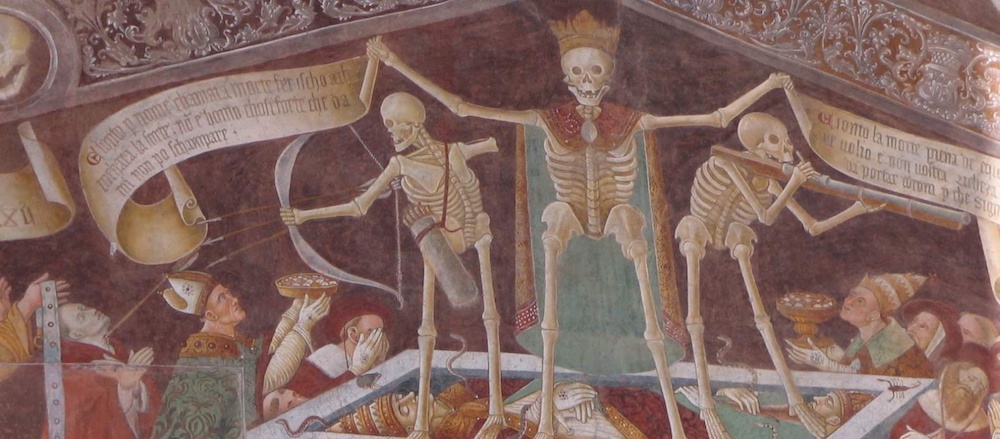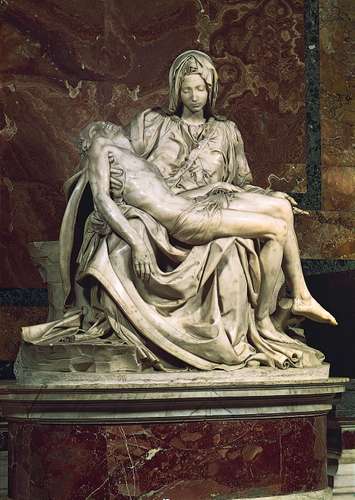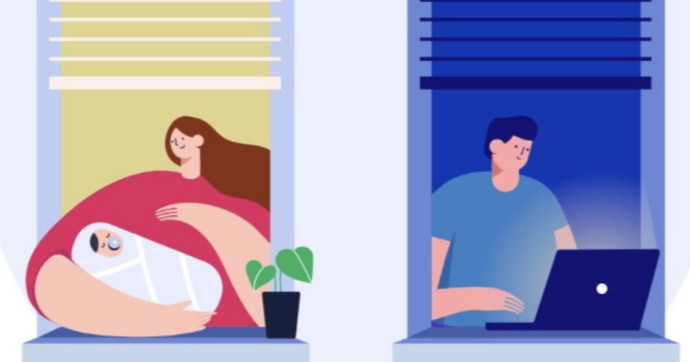In the wake of the Black Death of 1348-50, a new artistic motif emerged: The Dance of Death. It conveyed to viewers, many among them illiterate, that the plague killed indiscriminately: death took the lives of queens, bishops, and peasants alike. Except that the message was not truer then than it is now. The medieval Dance of the Dead was propaganda.

Some of the most remarkable frescoes with this motif survive in Clusone, not far from Bergamo, in Lombardy, the region of Italy that has been hit hardest by Covid-19. In Italy, as everywhere else, the current pandemic has exacerbated existing inequalities of class, gender, and race. Visual culture and the official government language have only compounded this trend.

 In March 2020, as the hospitals and ICUs of northern Italy were overflowing, a young artist’s drawing went viral. It portrayed a female doctor with the wings of an angel holding the Italian peninsula in her arms as she would hold a wounded body. In a country in which public culture remains profoundly Catholic, the reference to the Virgin Mary cradling the dead body of Christ, famously sculpted by Michelangelo, was unmistakable. Both public health authorities and Catholic NGOs used the image to publicize their efforts to combat the virus.
In March 2020, as the hospitals and ICUs of northern Italy were overflowing, a young artist’s drawing went viral. It portrayed a female doctor with the wings of an angel holding the Italian peninsula in her arms as she would hold a wounded body. In a country in which public culture remains profoundly Catholic, the reference to the Virgin Mary cradling the dead body of Christ, famously sculpted by Michelangelo, was unmistakable. Both public health authorities and Catholic NGOs used the image to publicize their efforts to combat the virus.
As soon as the Italian government began to plan a gradual reopening after two months of lockdown, normative presumptions about gender and the family were again on display. A decree issued by the office of the prime minister ruled that beginning on May 4, 2020, people could again meet outside of their homes, but only with their “relatives” (congiunti) from the same region. When asked what the government meant by relatives, its representative answered: spouses, live-in partners, civil union partners, anyone sharing a stable emotional bond, as well as blood relatives up to the sixth degree and kin up to the fourth degree. The initial formulation is all too telling of how government officials assumed the family to be the pillar of society and everyday life. They had taken “relatives” to be so self-explanatory that, it was soon revealed, they had chosen a term (congiunti) that is nowhere to be found in the Italian civil code, which uses only two other words to mean blood relatives (parenti) and in laws (affini). Therefore, the unusually capacious follow-up definition of who could be considered a relative for the purpose of the May 4, 2020 decree is, at worst, proof of the incompetence of the bureaucrats who drafted it and, at best, an implicit admission that anyone should be free to choose with whom to share stable emotional bonds and, if they so wish, to call them their family.
For a few days, caught by surprise by the intense reaction to its definition of the word “relatives,” the government even toyed with the idea of including “friends” in it. The possibility was soon rejected, but once we look closely at the entire episode, something important comes into focus: as soon as the state sought to give an inclusive definition of the family that stretched beyond a strictly legal designation, it could not set a limit to the range of emotional and social arrangements that people understand as foundational to their lives. The disjunction between this reality and Michelangelo’s pietà –the blessed mother who accepts to sacrifice her son for the redemption of humanity– could not be greater. So why continue to cling to a secular version of this iconic image even in the midst of a pandemic that has upended all semblance of normalcy?
 As if the May decree had not sparked enough hilarity and controversy, a month later the Ministry of Technological Innovation and Digitization, headed by a woman with a Ph.D. in Business Administration, announced the availability of a new app, called “Immuni,” to help trace coronavirus infections across the national territory. For those who downloaded it in the first days of June, it showed a woman and a man at the windows of their apartment: she holds a newborn; he types on his laptop. A former MP and one of the very few openly gay women in Italian politics, Anna Paola Concia, asked in a tweet that the image be removed because Italian women did not deserve to be portrayed only as wives and mothers. And removed it was. But one wonders about all the women and men who had vetted the image before it was launched.
As if the May decree had not sparked enough hilarity and controversy, a month later the Ministry of Technological Innovation and Digitization, headed by a woman with a Ph.D. in Business Administration, announced the availability of a new app, called “Immuni,” to help trace coronavirus infections across the national territory. For those who downloaded it in the first days of June, it showed a woman and a man at the windows of their apartment: she holds a newborn; he types on his laptop. A former MP and one of the very few openly gay women in Italian politics, Anna Paola Concia, asked in a tweet that the image be removed because Italian women did not deserve to be portrayed only as wives and mothers. And removed it was. But one wonders about all the women and men who had vetted the image before it was launched.
Italy today is among the advanced capitalist democracies with the lowest rate of women’s participation in the workforce and the highest gender gap in managerial jobs. Domestic violence against women was high even before the sheltering-in-place orders of this past Spring. Laws and attitudes toward LGBTQ individuals remain highly discriminatory. It was only in 2016, much later than in most member states of the European Union, that the Italian parliament legalized same-sex civil unions, while same-sex marriage and adoption remain illegal.
As workplaces began to reopen in May 2020, it was reported that a great many working women would continue to stay at home to tend to their children as long as schools remained closed, while men would return to their jobs.
 A mysterious and potentially lethal virus has forced millions of people to re-assess their most proximate and intimate relations. Whom can we see in person? Whom can we hug? Whom can we only call or see on screen, assuming we have the means to do so? Many found themselves isolated and without a support system. Others, including victims of domestic abuse (often women and children) and LGBTQ teenagers living under the same roof as homophobic parents, wished they could run away from their household members. Women have been in the front line among first responders and essential workers; the luckiest among them spent long stretches of time away from home because they had a place to rest at the end of their shifts where they did not risk spreading the virus to their loved ones. What else will it take to dislodge gender stereotypes and normative assumptions about the family from Italian visual culture and public discourse?
A mysterious and potentially lethal virus has forced millions of people to re-assess their most proximate and intimate relations. Whom can we see in person? Whom can we hug? Whom can we only call or see on screen, assuming we have the means to do so? Many found themselves isolated and without a support system. Others, including victims of domestic abuse (often women and children) and LGBTQ teenagers living under the same roof as homophobic parents, wished they could run away from their household members. Women have been in the front line among first responders and essential workers; the luckiest among them spent long stretches of time away from home because they had a place to rest at the end of their shifts where they did not risk spreading the virus to their loved ones. What else will it take to dislodge gender stereotypes and normative assumptions about the family from Italian visual culture and public discourse?
